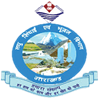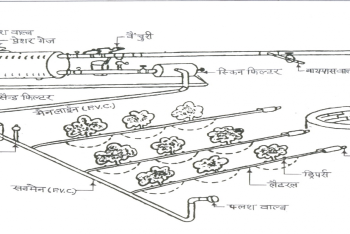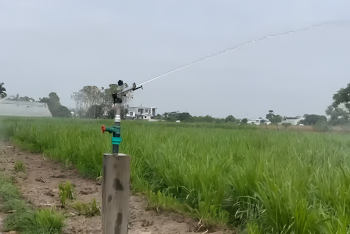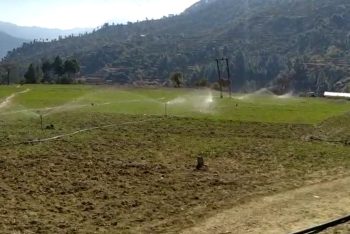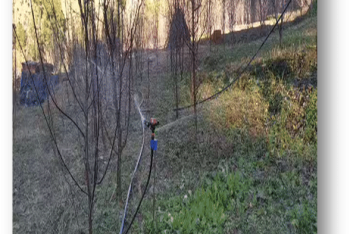Minor Irrigation System – (Drip, Sprinkler and Raingun Scheme)
Much less water is required when using Minor irrigation methods (drip, sprinkler, raingun etc.) as compared to traditional irrigation. This also stops excessive water exploitation through tubewells in plain areas. There is less wastage of water in modern systems for irrigation (drip, sprinkler, raingun etc.). Traditionally, the irrigation efficiency of canal and flood irrigation is 30 percent, while the irrigation efficiency through sprinkler system is 70 to 75 percent and irrigation efficiency through drip irrigation system is 90 percent.
Irrigation through sprinkler/drip requires less water as compared to traditional irrigation/flood irrigation, due to which it becomes possible for the farmer to irrigate more area with less amount of water, as well as crop productivity increases.
The process of artificially providing water to plants is called irrigation. Irrigation water is used by spreading water on the land surface, by spraying water or by applying it drop by drop near the roots of the plants. Surface irrigation, sprinkler irrigation, drip irrigation and subsistence irrigation are the popular methods of irrigation. Irrigation water is given to the plants on the ground surface, under the ground, by sprinkling or by dripping. Which method of irrigation is used depends on the source of water, type of soil, topography of the land and type of crop.
Minor irrigation methods: This includes those methods in which less amount of water is used for irrigation, but it has a positive effect on agricultural production such as sprinkler/sprinkler irrigation system, drip irrigation system. Its details are as follows:-
Fountain/Sprinkler Irrigation System: Under this system, water is passed through a pipeline at high pressure from the water source to the field where the last end is the sprinkler. Due to high pressure and water flowing through a small hole, water is converted into small droplets and is made available for irrigation in the field in the form of artificial rain or shower. That is why this system is also called sprinkler irrigation system.
Drip Irrigation Method:-Drip irrigation method is the most modern method of irrigation. In this method, water is saved a lot. Under this method, water is applied to the roots of the plants drop by drop. In this method, wastage of water is negligible. That method has been found to be very successful in crops sown far away such as:- Mango, Angul Papaya etc.
(Advantages of drip irrigation system):-
- High water use efficiency, up to 95 percent (50 to 70 percent water saving).
- Maximum crop production per hectare (50 percent increase in production)
- Savings in fertilizer.
- Low seed growth.
- Can be used in rough areas without leveling.
- Saline water can be used.
- Inter-cultivation with irrigation is possible.
- 30 to 40 percent energy saving.
- Good watering of plants by using the system.
(Difficulties in use):-
- Initial cost is high.
- Problem of system getting blocked.
- Useful only for crops sown far away.
- Design, installation and operation of the system is difficult, for which training is required.
[/vc_column_text]
Design of drip irrigation system:-
Drip irrigation system is a low pressure system and it generally works at 1 kg/cm2. Its design is very complex. If the system is not designed properly, then the system will not work properly and some plants will get more water and some plants will not get any water at all. Therefore, the design of the drip system is very important for its success.
The design of the system depends on the water requirement of the plants, the diameter and length of the pipes of the main line, sub-main line and lateral line, type of soil, slope of the land, discharge of the dripper, etc. Even a slight change in any of these changes the design.
Water requirement:-
For the successful operation of the drip irrigation system, it is necessary to calculate the correct water requirement because through this method only the amount of water required by the plants is given. The water requirement of the plants keeps changing seasonally and every month and accordingly the working hours of the system are balanced. Water requirement for different crops can be determined by the following formula:-
Installation of drip irrigation system:-
While installing drip irrigation, special attention should be paid to the following points:-
- At the time of installation, lateral line, sub-main etc. should be installed as far down slope as possible, so that the net energy loss is minimized. tank.
- Generally, sub-main and main should be underground.
- The drip system should be protected by fence so that animals etc. do not damage it.
- Pump filter, fertilizer tank etc. should be installed on a paved platform and if the pump water is being lifted from a tank, then it should be covered.
- Location of drippers is very important if there are nearby plants like papaya, vegetables etc., then drippers should be installed on the lateral line near the plant. If the crop is of plants far apart like lemon, guava, mango etc. then drippers should be installed on a loop line at some distance from the trunk of the tree. If it is an old garden then while installing the loop line, it should be kept in mind that how far the roots of the tree have spread. Installation of drippers in trees and vines will depend on the planting pattern and distance. The general principle in installing drippers in them is that the entire area around the tree should remain continuously wet and no dry place should be left.
- Generally one lateral should be used for one line of plants.
- The position of the main line should be such that irrigation can be done on both sides of it.
- The size of the sub plant should generally be 1 to 2 acres.
Operation and maintenance:-
There is no moving part in the drip irrigation system, so if the system is used properly, then the system requires maintenance like a pump. The following points should be kept in mind for the operation and maintenance of the drip irrigation system.
- The place where the system is installed, animals should not be allowed to enter, otherwise the system may get damaged.
- Generally the system is run for half an hour or one hour every day. In case of extreme changes in the weather, it becomes necessary to change the operational hours.
- To make the drip irrigation unit more useful, it is necessary that along with the installation of the system, such crops should be taken along with the main crop which start giving immediate returns, for example:- Pomegranate plants can also be planted in the seasonal garden in the first four years. Seasonal plants will bear fruits in four years and pomegranate plants will bear fruits in 1.5 years.
- The main problem in using drip irrigation is the blockage of pipes and drippers. For this, along with having an effective filter unit, it is necessary to clean the filter once a month. If there is more dirt in the filter, then the filter can be cleaned more quickly. Apart from this, flushing of lateral lines and submains etc. should also be done once in six months. It is also necessary to test the physical and chemical properties of water so that chlorination and acidification can be determined as per the need.
- Drip lateral lines and drippers etc. are made of plastic material, hence no sharp object should be used on them.
- Special arrangements are necessary to protect from rats etc. otherwise rats cut the pipes, hence antirodents should be used as per the need.
- Drip irrigation method does not cause compaction of soil, hence there is very little need for tilling. Therefore, irrigation should be done very less and while doing irrigation, care should be taken that the laterals and drippers are not damaged.
- Drippers should be installed at some height from the ground.
- Parts of the lateral line that get damaged or drippers get broken should be replaced.
Sprinkler irrigation
Sprinkler irrigation is a method by which water is sprayed in the air and this water falls on the land surface in the form of artificial rain. Spraying of water is obtained in a small nozzle or orifice by pressure. Water pressure is also obtained by pump. Since artificial rain is done slowly, neither there is accumulation of water anywhere nor the soil gets pressed. This maintains the best ratio of soil and air and the seeds also sprout quickly.
This is a very popular method by which about 30-50 percent of water can be saved. It is being used in about seven lakh hectares of land in the country. This method is used in sandy soil, uneven land and where water is less available. Wheat, cotton, groundnut, tobacco and other crops can be irrigated by this method. By irrigating through this method, the cost of maintenance of plants is less and diseases are also less.
Sprinkler irrigation method
Main components of sprinkler irrigation system:- The main parts of sprinkler irrigation system are pump, main pipe, side pipe, water lifting pipe and water spraying sprinkler.
Working method of sprinkler irrigation system:- In sprinkler irrigation, water is sent in the pipe with pressure by the pump, due to which the crop is sprayed by the sprinkler. The main pipe is connected to the side pipes. The pipe for lifting water is connected to the side pipes.
The length of the pipe for lifting water, which is called riser pipe, depends on the length of the crop. Because the riser pipe has to be kept higher than the height of the crop. Generally, it should be equal to the maximum length of the crop. The water sprinkling heads are rotating which are attached to the water lifting pipe.
The water sprinkling machines sprinkle water on the entire area of the land i.e. on the crop. Due to pressure, water is sprayed to a great distance. This leads to irrigation.
In this method, pump unit, sand umbrella, pressure gauge main line, sub-main line, pressure control screw, riser line, sprinkler head and final screw are used. All the parts of the machine used in this method are shown in the picture.
Where only saline water is available for irrigation, more yield can be obtained by this system.
Advantages of Sprinkler Irrigation:-
- In surface irrigation, 15.20 percent of water remains unusable till it reaches the field.
- This loss increases to 30.50 percent with canal water and the water does not reach uniformly in surface irrigation whereas with sprinkler irrigation, the irrigated area increases 1.5 – 2 times
- That is, by irrigating with this method, up to 25.50 percent of water is directly saved. • When water is sprinkled like rain, waterlogging does not occur on the land.
- Due to which, water overflowing does not cause any damage as the sprinkling is less than the rate of water absorption by the soil.
- At places where the land is uneven, surface irrigation is not possible, in such places sprinkler irrigation proves to be a boon.
- Sprinkler irrigation is the best method for sandy soil with high slope and uneven places.
- By irrigating with this method, the appropriate level of moisture is maintained in the soil due to which the growth, yield and quality of the crop remains good.
- In this method, soluble fertilizers, insecticides, pesticides or weedicides can also be easily used with the irrigation water.
- By irrigating with sprinkler irrigation method before frost, the crop does not get damaged by frost due to increase in temperature.
- Water shortage is limited In areas where water is available, double to three times the area can be expected to be irrigated.
Maintenance and precautions
Sprinkler irrigation should be tested at the time of use and after use and by taking some important precautions the set will run well. For example. The irrigation water used should be clean and free of sand and high amount of soluble elements and after using fertilizers, fungicides/weedicides etc. the entire system should be cleaned with clean water.
Plastic washers should be inspected and replaced as per need. Rubber seals should be kept clean and after use other fitting parts should be separated and cleaned and then stored in a dry place.
Limitations of sprinkler irrigation
- In case of excessive wind, the distribution of water is not uniform.
- Ripe fruits should be protected from the sprinkler.
- Continuous water supply is required for the correct use of the system.
- The water should be clean, there should be no sand, garbage in it and the water should not be salty.
- More energy is required to run this system.
- Irrigation through this system cannot be done in areas with clay soil and hot air.
- The benefits of irrigation through sprinkler can be provided to almost every type of crop.
- There is no need to build drains or dams, due to which more land is available for farming.
Drip irrigation system: Under this system, pipes are laid from the water source to the field. Water is made to flow at low pressure in the line where the last end is the emitter (drip). Due to low pressure and controlled flow of water from small holes, small droplets of water are made available in the form of drips for irrigation in the field. Therefore, this system is also called drip irrigation system.
Operation and maintenance of Minor irrigation systems:
The following points should be kept in mind in sprinkler/sprinkler/drip irrigation systems:
- Animals should be prohibited from entering the place where the system is installed, otherwise the system may get damaged.
- Generally the system is run for half an hour or one hour every day. In case of extreme changes in weather, change in operational hours becomes necessary.
- To make the drip irrigation unit more useful, it is necessary that along with the installation of the system, a crop should be taken along with the main crop which starts giving immediate returns, for example: Pomegranate plants can also be planted in the seasonal garden in the first four years. Seasonal plants will bear fruits in four years and pomegranate plants will bear fruits in 1.5 years.
- The main problem in using sprinkler/sprinkler/drip irrigation system is the blockage of pipes and drippers/nozzles. For this, along with having an effective filter unit, it is necessary to clean the filter once a month. If there is more dirt in the filter, then the filter can be cleaned more frequently. Apart from this, flushing of lateral lines and submains etc. should also be done once in 6 months. It is also necessary to test the physical and chemical properties of water so that chlorination and acidification can be determined as per the need.
- Drip lateral line and drippers etc. are made of plastic material, hence no sharp object should be used on them.
- Special arrangements are necessary to protect from rats etc. otherwise rats cut the pipes, hence antirodents should be used as per the need.
- Drip irrigation method does not cause compaction of soil, hence very little weeding is required. Hence, weeding should be done very little and while weeding, care should be taken that the lateral and dripper are not damaged.
- Drippers should be installed at some height from the ground.
- The parts of the lateral line which get damaged or the dripper gets broken should be replaced.
